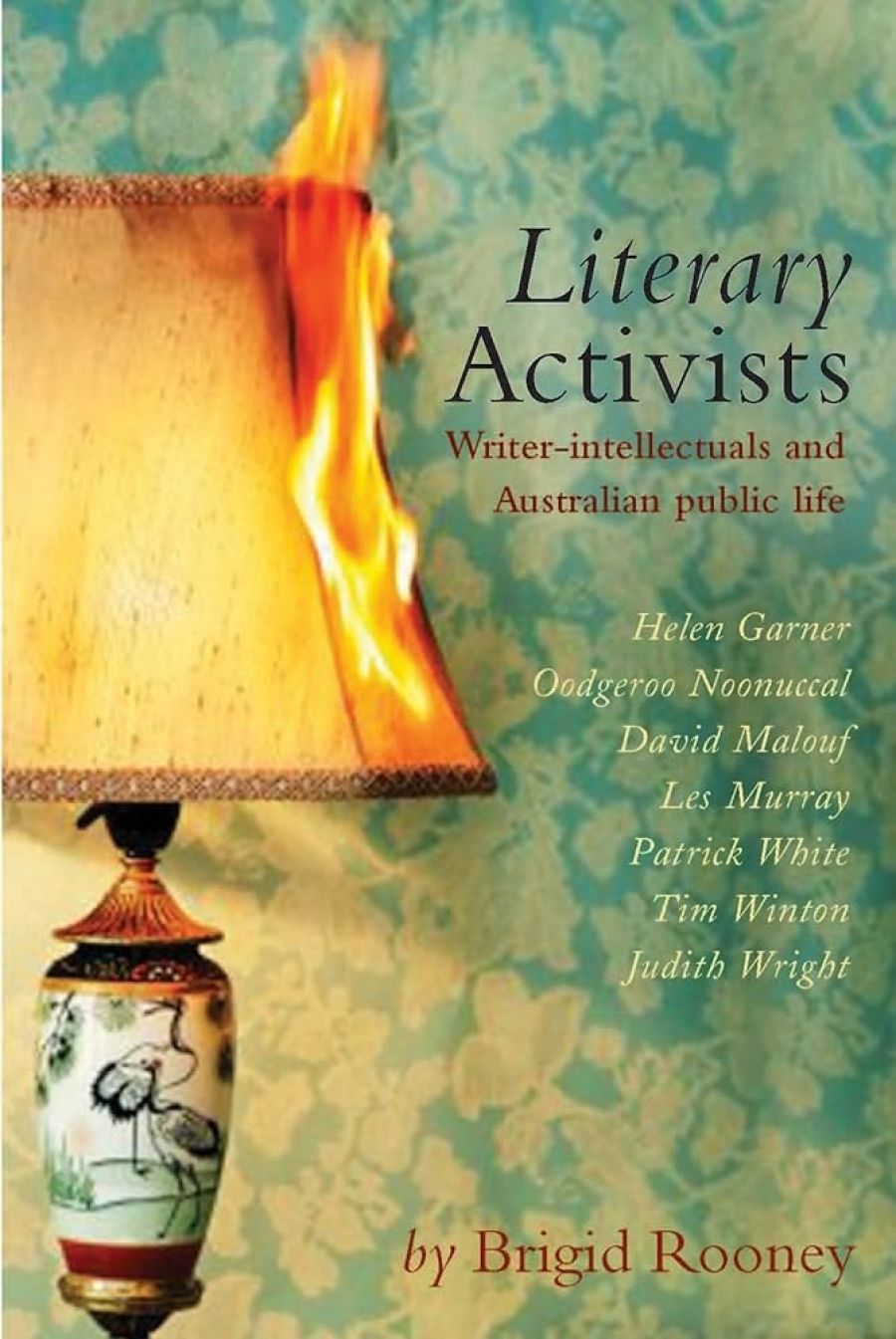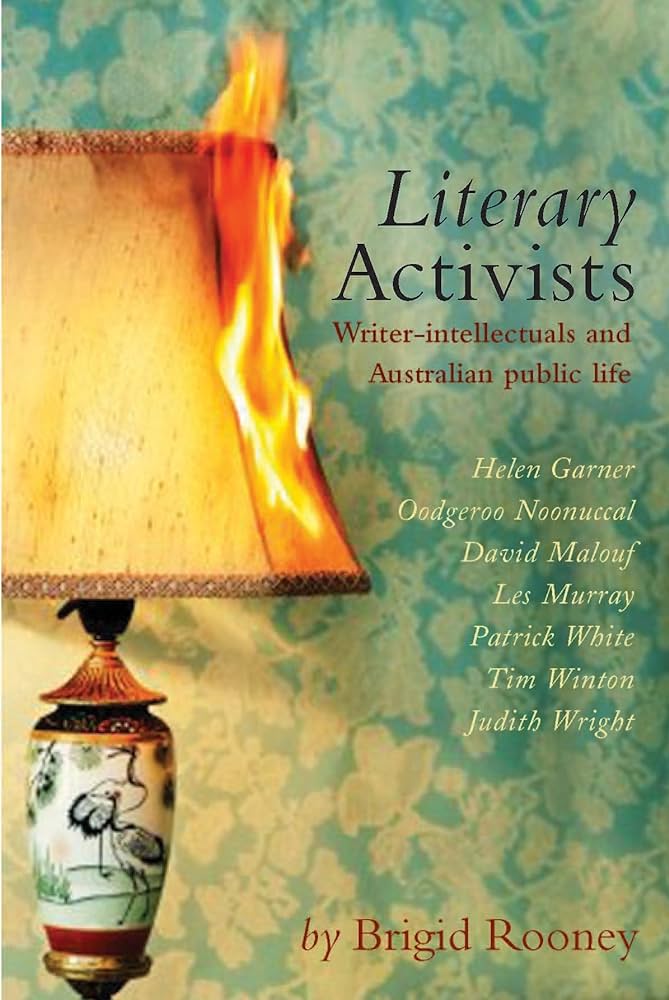
- Free Article: No
- Contents Category: Literary Studies
- Review Article: Yes
- Article Title: Moving on
- Online Only: No
- Custom Highlight Text:
While rehearsing in Martin Place for the recent Sydney Festival, my daughter found herself dancing on a plinth while a heckler below chanted ‘Wanker!’ throughout. On another platform, her fellow artists, all of them performing their intricately choreographed work, endured the calls of another passer-by, ‘You’re so predictable!’ In Australia, everybody’s a critic.
- Book 1 Title: Literary Activists
- Book 1 Subtitle: Writer-Intellectuals and Australian Public Life
- Book 1 Biblio: UQP, $34.95 pb, 260 pp, 9780702236624
- Book 1 Cover Small (400 x 600):

- Book 1 Cover (800 x 1200):

It is a frustrating situation where any concern for aesthetics is taken as a sign of class snobbery. Rooney addresses it directly by considering a series of writers, acclaimed for their literary skills, who have intervened in political debates. Her subject – the debate between aesthetic values and political activism in literature – has led to the dismissal of whole areas of literary art by one side or the other, and she tries to find ways to reconcile the two. She surveys political engagement by writers from White and Judith Wright to Tim Winton, with a coda considering Eva Sallis and Richard Flanagan.
Judith Wright, the poet promoted in the high school classrooms of the 1960s, provides a guiding example of the ‘canonical’ poet who gave herself to activism, firstly on environmental issues and then on Aboriginal rights. By the 1970s she sat on committees advising governments and devoted her energies primarily to environmental issues, leading to the assumption that political commitment had displaced her art. Rooney, however, reads Wright’s late poetry in the light of this politics, and explicates the relationship between Wright’s poetic journey and her commitments. She later provides a moving account of Wright’s relationship with Oodgeroo Noonuccal based on poems and manuscript letters, and shows that Wright’s initial support for Oodgeroo developed into a more equal and complex exchange, with Wright learning as much from her friend as she taught.
Rooney makes a neat connection between Wright and Les Murray, telling us about their encounter at the University of New England in 1967 and acknowledging their shared concern about the imaginative ownership of the land. The chapter on Murray is, perhaps, her most insightful and original, as she notes the patterns of pain and victimhood in Murray’s poetry and self-mythology. She identifies the monstrous feminist in The Boys Who Stole the Funeral (1980) as a ‘clichéd inversion’ of the Weeping Man found so often in Murray’s poetry, and she reads Fredy Neptune (1998) as a gesture of reconciliation and compassion. The disparity between Murray’s international reputation and his mixed reception at home leaves room for further questions about his achievement: is he a progressive visionary who has transcended a brutal colonial history to liberate the national consciousness, or a ‘radical folk conservative’ who resists the enlightened attitudes of modern urban Australia? No doubt each reader has a view on that.
David Malouf proves even more difficult to pin down, with his ‘aestheticised’ depictions of the past and concern to find moments of epiphany that transcend nasty aspects of reality. Furthermore, Rooney and others implicate middle class urban white readers, even the ‘typical ABC Radio National’ audience in Malouf’s reconciliatory gestures. Perhaps reconciliation is just a means for white Australians to consolidate their own sense of belonging. Just as Wright’s early attempts to give white Australians an imaginative connection with the place where they live came to be seen as complicit with the colonial appropriation of that land, Malouf’s writing towards a spiritual healing may be read as absolving white readers of their anxiety and guilt about dispossession of the Aboriginal peoples.
There is plenty of material for debate here, and Rooney often stops just at the point where you want her to give a firm opinion. She generally takes a cautious approach, placing her readings within supporting comments from other critics and resisting the temptation to polemic. In the chapter on Helen Gamer, though, her caution seems to confirm Gamer’s point about the timidity of contemporary intellectual life. Like other academic critics of Joe Cinque’s Consolation (2004), Rooney misunderstands the nature of subjective non-fiction writing. Gamer was not obliged to write a ‘fair and balanced’ account of the case against Anu Singh, nor ‘to imagine all viewpoints fearlessly’. Rooney herself is so anxious not to appear biased that she declares, ‘I have no way of gauging [Singh’s] guilt’. But the court found Singh guilty of killing Joe Cinque (manslaughter, not murder). The refusal to accept this tends to support Gamer’s view of the relativist morality pervading our intellectual life, where no one can be held responsible for their actions. The relegation of Gamer to a ‘best-seller’ rather than a literary writer raises further questions about the way ‘élite’ academics resist the interests of readers in the wider community. Of course, you can always call these readers ‘middlebrow’ or ‘a typical Radio National audience’ to put them in their place.
Rooney’s book provides an excellent starting point for the arguments that we should be having about our writers and their work. She carefully puts forward the background and the critical responses to each work before embarking on convincing, and often enlightening, readings of particular texts. In fact, her discussions often seem too brief as she hastens to deal with the next writer on her list. Winton, for example, appears a less interesting case for discussion, and the connection is not so clear between his fiction and his decision to become active in saving the Ningaloo Reef. Perhaps there are times when writers are merely people using what power they can muster to achieve a political result.
In almost every case, the writers have concerned themselves with the politics of the environment and with the protection of human society against the destructive forces of technology. Many of them grapple with the ambivalent status of white Australians who want to belong to and love the land they live in, but cannot ignore the history of colonisation. Their activism rarely stems from a political philosophy or party commitment. Rather they take a position traditional for Western artists, criticising and challenging the destructive and dehumanising aspects of modernity. Gamer and Murray, in particular, prefer to speak in an individual voice, rather than ally themselves with activists in the community.
There is a difference, then, between writers such as Wright, White, and Winton, who give themselves to some cause, and those, like Garner, whose writing itself represents their ‘activism’. The trouble is that in Australia, where journalists still ‘rule the intellectual roost’, as White claimed, literary writing only gains public attention when controversy and division are involved. In an effort to transcend this kind of scrapping, Rooney applies Pierre Bourdieu’s metaphor of the ‘literary field’ to encompass the range of writing from the literary to the popular, with the implication that literature reinforces existing power structures. I suspect, though, that in Europe high culture and privileged class positions may still go hand in hand; the word ‘élite’ implies a kind of aristocracy, with financial, political and social, as well as cultural, power. When Rooney writes about the urban professional middle class as a single privileged group or speculates about middlebrow readers, I wonder how accurate such formulations can be for Australia.
At the Sydney Festival, I saw the Canadian Robert Lepage’s Lipsynch, an epic theatrical work that shows no hint of élitism, though it ranges from opera to philosophy to soap opera. It moves across geographical and linguistic boundaries, connecting the lives of people from all levels of society in a meditation on the relationship between communication and human emotion. It left me wondering whether Australians can ever escape a preoccupation with national circumstances and look outwards beyond divisions of class and race to achieve this kind of art and understanding. Rooney’s thorough analysis of the ways that some of our literary artists have engaged with Australian society over recent years may help us move on.


Comments powered by CComment